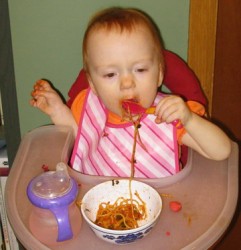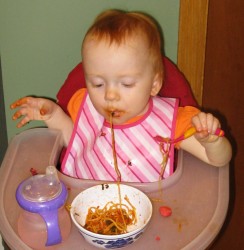Toddler Tastes
A few months ago on his blog, Anthony Bourdain was musing with horrified dread on the subject of what he would feed his infant daughter when she started eating solid food.
A lot of foodie moms (myself included) posted with the hopefully helpful advice that babies and toddlers will eat what you feed them. That is to say, if they never get a taste of Chicken McNuggets in the the first place, they won’t insist on a diet that consists only of questionable chicken parts nuggetized and breaded with unknown substances and deep fried in half-degraded oil.
Watching Kat eat her own little bowl of Kiss Kiss Bang Bang Spaghetti the other day made me realize that I hadn’t really talked about how toddler’s tastes change and how to guide those tastes toward healthy, delicious food choices.
So far, Kat still tends to prefer flavorful, healthy foods, although she does love her ice cream, chocolate preferably. She doesn’t get much in the way of cookies or cake or candy, simply because we generally don’t keep such foods around our house. She still most often shares our meals with us, although there are some foods she doesn’t seem to like much. Cow milk, except in the form of cheese, preferably sharp cheddar, cream, ice cream or yogurt lassi, is on her “I don’t consume it” list. Meat is a sometimes food as well: some days she will refuse it, while at other meals, she cannot get enough of it. I have noticed that she tends to prefer chicken and pork to beef, but what she seems to prefer above all meat is eggs. (Kat really digs Cilantro Chicken Stir Fry–she eats that chicken so fast I can barely keep up with shredding it into little bites for her.)
She likes scrambled eggs so much that Zak has taken to calling her “The Oviraptor.” She can power through one to two extra large farm fresh eggs from pastured hens in record time, gobbling them up using both a spoon and a hand, if the spoon method is too slow. She likes the way I cook them best–well beaten with a tiny bit of cream, a sprinkle of herbs and slowly cooked with a bit of butter–all local. At the end, I add a sprinkle of shredded sharp cheddar and serve it forth to her great appreciation.
Fruits and vegetables are a seesaw ride. One day she cannot get enough of oranges and tangerines, then two days later, they are the untouchables of the citrus world. Apples are beyond great one minute, and the next, she is tossing them to the cats as outcast unclean. Asparagus is viewed with suspicion when sauteed in butter, but let it be cut up in a creamy pasta dish and it is better than good and is pounced upon and gobbled up. Tomatoes are almost always the best beloved, although now and again they are given a fierce toddler glare that eloquently says, “I don’t think so.”
Noodles of all types, both Western and Asian, are a great hit, as is anything over or in rice. Pasta, especially long thin noodles, have the extra bonus of providing dinner time entertainment to Mommy, Daddy, Big Sister and any of the assorted dinner guests who happen to sit down with us. Tomato based sauces made with my home-canned tomatoes are greatly favored, but she also likes vegetable pastas with creamy cheese sauces too. Asparagus and spinach are great in her book if noodles are involved, and peas taste better when mixed into macaroni and cheese, a dish which we have renamed “Cheez n’ Peaz.” Kat loves her Cheez ‘n’ Peaz, although in typical toddler fashion, while she may eat peas with gusto one day, she may pick them out of her bowl and set them aside the next day.
That toddler tendency to eat a food one moment and refuse it the next is probably one of the must frustrating aspects to feeding a child of Kat’s age. Some kids grow out of it by three, others continue in this irritating and confounding behavior until they are eight or nine years old. I think that the best way to deal with it is to not make a fuss about it, and if a kid doesn’t eat one thing, offer something else–within reason–and then offer the once offensive food again in a day or so. Be laid back about it, though, because in my experience, the more attention paid to the behavior by a parent, whether positive, in the form of offering a dizzying array of food choices all of which the child may refuse just for the pleasure of feeling their own personal power, or negative, in the form of berating, cajoling, coercing or otherwise making a divisive issue of food, the more likely the child is to continue in the behavior, because they are rewarded by this attention.
When Kat refuses to eat something, I just shrug and offer something else. If she doesn’t eat that, I figure she probably isn’t really hungry. Most kids will not starve themselves, so I don’t worry–I just keep an eye on what she eats over a period of days, instead of looking at what she is eating or not eating this minute. When I look at it that way, I find that she does eat a varied, nutritive diet, it just may not seem so at every meal when she pulls the bizzaro toddler trick of only eating one specific food for a meal or two.
That is my best advice to parents–take the long view when it comes to what your kids eat. Pay attention to the big trends, not the momentary whims. I find that Kat’s appetite fluctuates depending on her growth patterns, her physical activity levels and her, uh, digestive status. (In other words, if she hasn’t had a bowel movement in several days, it stands to reason that she might not eat much. Little bellies can only hold so much, and sometimes room needs to be made before a meal can go down.)
And when the momentary whims get you down, try and shrug your shoulders and ignore them. Feed them a varied diet in as calm and matter-of-fact way possible, and while you are at it, let them taste what you are eating, even if you think it is too spicy and they won’t like it. (Within reason–no steak tartare or raw fish for babies, please!) They may surprise you and love it–Kat still adores all sorts of curries, and as you can see the allium-laden Kiss Kiss Bang Bang really was a big hit with my little highchair dweller.
Let toddlers see you and other adults and kids enjoying food, making appreciative noises and sounds. Let them experience laughter and conversation at the table, maybe even a tiny drop of wine from your fingertip, and offer a lick of garlic butter from your spoon. Start them on the sensual pleasures of food early and you will eventually have a life-long food lover on your hands.
In other words, make food fun, not a fight, not just for your kids’ sake, but for your own as well.
15 Comments
RSS feed for comments on this post.
Sorry, the comment form is closed at this time.
Powered by WordPress. Graphics by Zak Kramer.
Design update by Daniel Trout.
Entries and comments feeds.






Hate to break it to you, but I’m 36 and still go on tears where I can’t get enough of a particular food and then I’m done with it for a while.
At least as she gets older, she’ll be able to say, “Mom, I’m just apple’d out today.” instead of keeping you guessing. 🙂
And I love the spaghetti coma pic.
Comment by Cindy — May 9, 2008 #
I enjoyed the post, and it made me think of how we took care of a kid-and-food issue. When my kids were little but school-aged, they felt strongly that they should get to have the same sugar-laden cereals their friends ate (and that they saw in television commercials.) So rather than clamp down and make them even more attractive through unattainability, we occasionally bought them and let the kids eat them… for dessert!
Comment by Hilarie — May 9, 2008 #
That picture of Kat with the spaghetti is adorable.
That was the approach my mother took with my sister and I, and we ended up eating damn near everything, being adventurous eaters, and avoiding pretty much every possible food neurosis. When I was about ten, I spent the night at a friend’s house, and was shocked to discover I wasn’t allowed to leave the table until my plate was empty. (I had a small problem with that — it was badly overcooked green beans and dry meatloaf. I was well-mannered to avoid criticizing it, but not masochistic enough to choke it down.) It just seems counter-productive to me; kids control so little of their own lives that when they figure out they can manipulate those around them with food, they’ll take the chance.
Comment by Elizabeth Yalkut — May 9, 2008 #
When my son was 2 or 3, he used to love to steal bits of veggies I was cutting up while preparing meals, and then he’d gobble them up and giggle. He especially loved stealing and eating raw garlic! To this day, (he’s 23 today!) he loves hot and spicy foods, espcially curries.
Comment by Maria DaCosta — May 9, 2008 #
Love the photos, and I think it’s great fun that she likes cilantro!
Comment by Kalyn — May 9, 2008 #
We started keeping chickens when our first child was a toddler, and I never worried about throwing food out if he didn’t want it.
Comment by Zoe — May 10, 2008 #
Plans, oh we gots ’em. But all it took was 1 visit with my Uncle and Z was forever hooked on T. Ramen noodles. Another visit and that was that, everything was fair game.
It takes everything I have to feed the boys halfway decently. When they’re babies it’s easy, but when they spend the afternoon playing at a friend’s house or with Uncle, game over.
Biggles
Comment by Dr. Biggles — May 10, 2008 #
Growing up, we had a “five bites” rule, with a “can you make the most dramatic face ever when you take those bites” corollary. I was pretty open to new foods, but my little brother was obsessively controlling about his food choices and incredibly picky until he was about 16. His broccoli faces rivaled a Calvin & Hobbes cartoon. He has subsequently recovered from his childhood pickiness, thankfully.
I think about food palates and aging often, as some foods that I loved as a baby (sweet potatoes and oatmeal, for example) and hated as a teenager are now back in my food repertoire, while some things I used to love (bananas) are less important. Being of the scientific bent, I’ve spent long hours conversing with some of my research buddies on the possible shifting nature of gene expression in terms of the G-proteins in our tongues and noses that moderate what we taste (or is it all in our brain chemistry? hard to say, probably both).
Textbooks tell me that toddler food choice is as much about establishing autonomy than anything else, but I think it’s fascinating that we can go through “palate trends” that sometimes last for years, or that we can gain or lose appreciation for things as we age. I think there’s more to it than just the psychosocial aspects of food choice.
And perhaps even more amusing – the things we lose a taste for seem more often to be the things that are bad for us (extra sugary, extra salty, fast food, etc), and the things we gain seem to be more healthful (like tofu, which my grandmother suddenly began to love at age 75).
Comment by Alexis E — May 10, 2008 #
Your little gourmande in the making is so gorgeous:-) I really enjoyed reading this piece and I agree about the point you made on food choices and power.
Comment by Mamlambo — May 10, 2008 #
I’ve been going back in time (not literally, alas) and looking at pictures of Kat when she was just born and as she grew, and she has not changed a bit! Well, she has, obviously, but her face has not changed as drastically as some babies’ faces do. When she was very little she had the same alert, interested-eyed, analytical look she does now in some of your pictures. I hope I have a baby like her.
Comment by Christy — May 10, 2008 #
I really enjoyed reading this one and generally agree. My observation is that children have a starting point (omnivirous, picky, colicky, whatever) and parents can influence from that point. If you have a picky child, there seems to be only so much you can do about it – short of pushing your kid to starvation to make your point. A certain youngling of my acquaintence is both picky and of delicate stomach, and will go without lunch for days on end at school if the food doesn’t meet her requirements.
Our Critter is relatively flexible and we encourage that by offering some of whatever we’re eating. If ze doesn’t like it, then it’s a laid-back comment of “OK, more for us.” And we try it on zir again the next time. Farmers’ Markets are great because of all the different foods cut up for sampling. At the Critter’s mealtime we’ll set out three or four foods current favorites, plus a past favorite or something new; whatever ze finishes we set out more of. It’s our version of “you pick, I choose” that gives us over-all control over what the Critter eats but ze gets choice as well. The hard part is making sure ze doesn’t substitute milk for all solids – all milk and no food makes Critter an unhealthy toddler.
Comment by Harry — May 12, 2008 #
But it totally makes sense if you consider that young children need proportionally more sugar and fat than adults, relative to their body mass. Cholesterol is a brain-building material, my kids need quite a bit, me, not so much.
Stuff I used to love as a child (the fat from steaks, yum) now tastes… pretty disgusting after the first bite or two. My four year old (who looks like a string bean) will gobble it up.
One a related note… I shudder when I see ads pushing foods full of artificial sweeteners to the preschooler crowd as “healthy” choices.
Comment by Agnès — May 12, 2008 #
Agnes: there was an article on BBC in April that British day care centers were, with the best of intentions, not meeting the nutritional needs of small children. They were providing too much fruit & veggies and not enough fatty protein. I’m not sure about the need for sugar but you’re dead on with the fats.
Comment by Harry — May 13, 2008 #
Agnes – touche. You make a very good point. I guess I wasn’t thinking about the healthy fats and sugars that fulfill the needs of young children, but rather the excessive fats/sugars/salt present in much fast food on the market. (On a side note: I’m all for feeding kids whole milk, fresh fruit with yogurt, nice pieces of steak and chicken, peanut butter, etc…. It’s the daily (or twice daily) cheeseburger and fries excess that troubles me. )
That said, I agree with you wholeheartedly that children probably do gravitate to such flavors because they do have greater nutritional needs. And perhaps I like beets more and french fries less because of my age and changing nutritional needs. I wonder what the spectrum of changing tastes is, as clearly not everyone loses that desire for high sugar/fat/salt, and I certainly have my moments (where only a milkshake and onion rings will do), so it would be interesting to look at the array of receptors in different peoples’ palates…..
Comment by Alexis E — May 15, 2008 #
I just love the “stoned-on-spaghetti” look on Kat’s face. So funny!
Comment by Roxanne — May 21, 2008 #